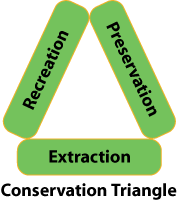|
|
|||||||||
|
Conservation Triangle – Extraction, Preservation and Recreation Much is said today about the changing lifestyle of people that allows more freedom for leisure time activities, more time for recreation. During their leisure time, people have the freedom to engage in a variety of activities and outdoor recreation is very popular. Some recreationists are informed and experienced; others are uninformed and inexperienced. The term "uninformed recreationist" refers to the guy that is gung-ho on going anywhere at anytime without a care in the world for what he is doing. Someone that has the attitude that they "own" the land and their “rights” come first, above all. An "enlightened recreationist" realizes that the land and its resources are the wealth of the nation and belong to the people of the nation. He accepts that it is not about going anywhere at anytime without a care in the world. His “rights” co-exist with the “rights” of others. The "enlightened recreationist" also realizes that routes are the key to access and natural resources are the reason for access. Routes were constructed to access the forests to harvest the trees for the lumber to build homes. Routes were constructed to mines where minerals and ores are extracted to provide raw materials to manufacture the goods used in our daily lives. Routes were constructed to access lands used for grazing of livestock that helps feed the people. When you look at history, there was a period in the late 1800s that was a low point in caring for the land and resources. Logging, mining and grazing practices of that era were not a shining example of efficiency or responsibility. There was plenty of waste. Extraction was king. Preservation was not an issue. Conservation was not an issue. Recreation was not a part of the equation. Survival was the primary concern.
As the years past, times changed. Preservation and conservation pressures increased. Logging, mining and grazing on public lands gave way to preservation of public lands. Recreation pressures increased. People changed their views about public lands. The routes still provide access to the natural resources for a changing purpose. The original goal of maintaining public lands for the public has changed from generating wealth, building homes, and providing food to providing camping, picnics, and a host of leisure time activities. Preservation and conservation are king. Recreation is growing. Extraction of resources from the lands is on the decline. Using public land for the good of the public (generating and sustaining wealth) is looked on as the evil incarnate. Routes constructed for support of extraction are key to recreation. Those routes are a bane to preservation. For public lands and the recreation cycle form a triangle. One point of the triangle is preservation. Another point of the triangle is recreation. The third point is extraction (logging, mining, grazing).
For aesthetics and symmetry, the triangle needs the balance of equal sides and angles. Preservation is fighting both recreation and extraction for control. Recreation is fighting preservation AND extraction. The extraction is losing. There are a few “enlightened recreationists” that realize the importance of extraction. The U.S. Congress established laws that govern the extraction industries. Under those laws, routes were constructed to support the mining, logging, and grazing. The routes recreation depends on exist because of mining, logging, and grazing. The loss of mining, logging, and grazing, removes the legal basis for the routes. Extraction needs the routes for access. Preservation wants the routes closed. Recreation wants the routes for access. Rival interests are in conflict. In the beginning was extraction. Preservation began to correct the abuses of extraction. Preservation is in conflict with growing recreation. Preservation is placing the wealth of the public lands out of reach - off limits to extraction and to recreation. The crux of the problem is getting extraction, recreation, and preservation working for the same goal; access. The issue is ACCESS and the goal is conservation. Conservation to provide for sustainable extraction of raw materials for economic needs. Conservation to provide for the social needs of recreating public. Conservation to provide for the preservation of natural wonders. Extraction, recreation, and preservation are of equal importance. It would be unwise for recreation or extraction or preservation to be the sole or dominant policy at the expense of the conservation. The bell is tolling for extraction and recreation. The “enlightened recreationists” understands the link between extraction and recreation. Preservation is at odds with extraction and recreation. Preservation wants more lands for wilderness. Extraction and recreation want more access to public lands. The triangle is out of balance. Change is needed. Recreation is growing. Options for recreational access to public lands are decreasing. Changes to laws governing wilderness and endangered species are needed; changes that support a balanced conservation goal. There are no quick and easy answers. It is going to take time, effort and pain. It is about balance. |

